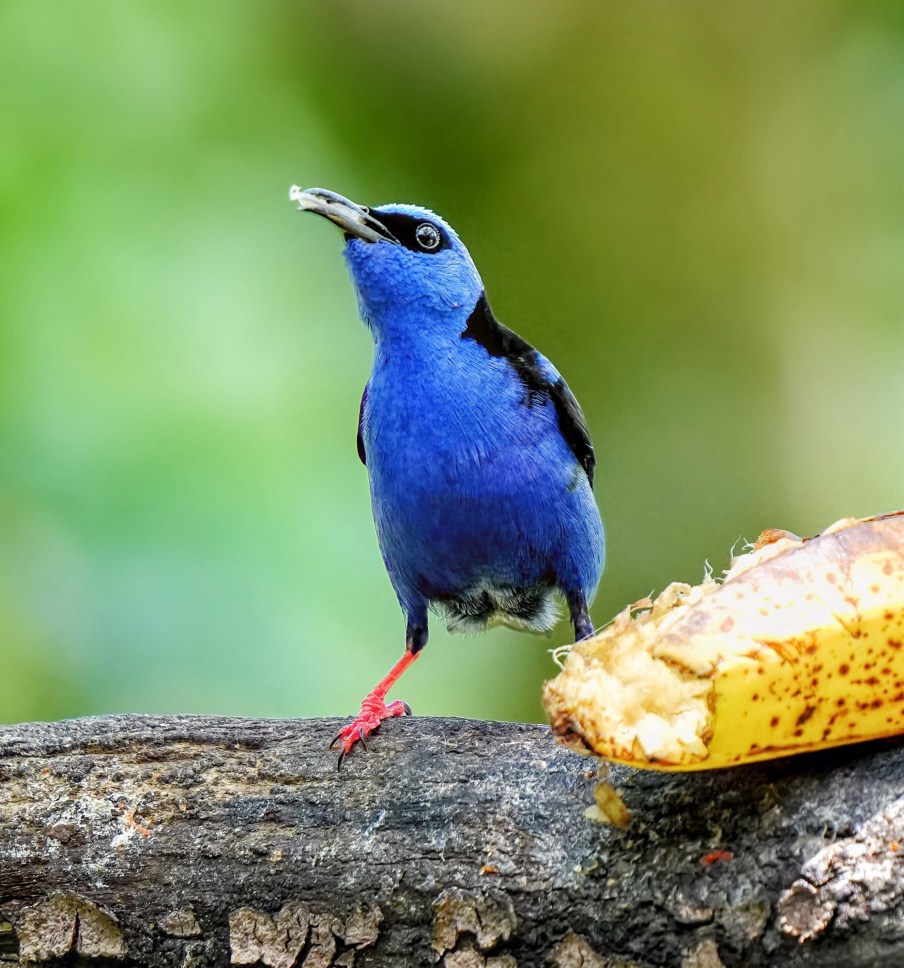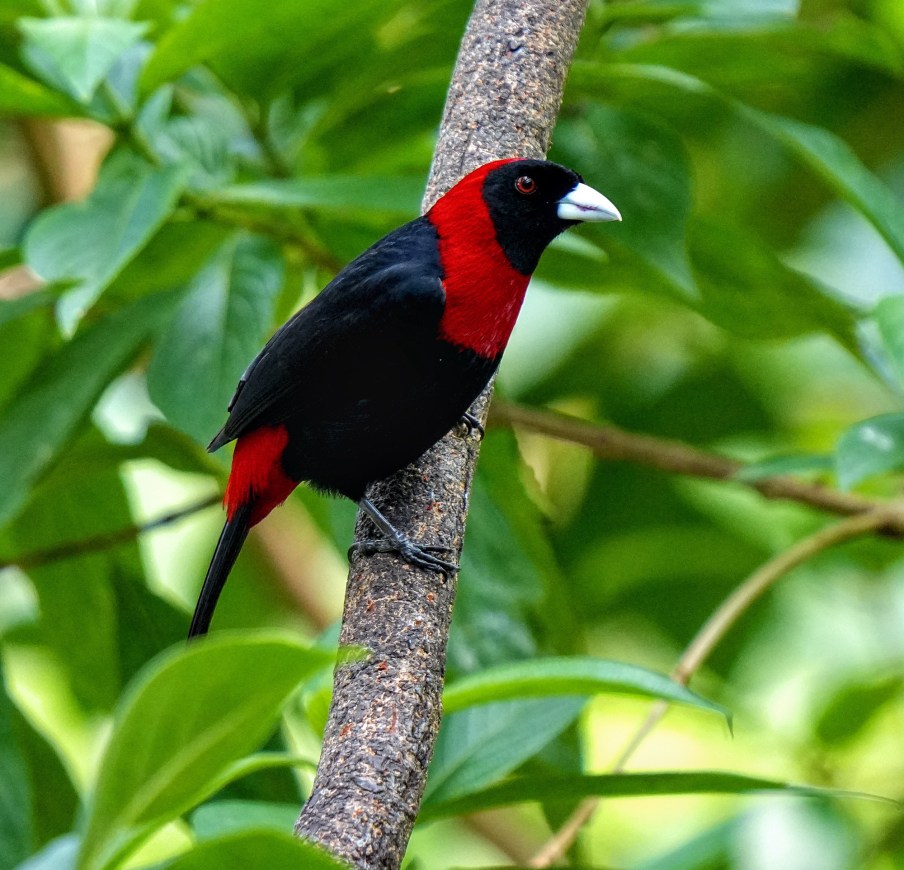Posts in Category: wildlife
Red-legged Honeycreeper


Red-legged Honeycreeper: Mirador y Soda Cinchona, San Jose, Costa Rica, March 2025 — The Honeycreepers are actually Tanagers, and we generally see at least 2 of them on any trip to Costa Rica. This Red-legged Honeycreeper, with the obvious name, was at the cafe in Cinchona to greet us. Sony a6700. Tamron 50-400 at 600mm equivalent. Program mode with my bird and wildlife modifications. Processed in Photomator.
Silver-throated Tanager


Silver-throated Tanager: Mirador y Soda Cinchona, San Jose, Costa Rica, March 2025 — The Silver-throated Tanager is among thee most common birds at the feeders at Cinchona. It is a tanger of the foothills and mountains, and tends to feed in small groups, and the whole group shows up at the same time. It is an attractive bird and would undoubtedly get more attention if it were not so common. Sony a6700. Tamron 50-400 at 600mm equivalent. Program mode with my birds and wildlife modifications. Processed in Photomator.
Scarlet-thighed Dacnis

Scarlet-thighed Dacnis: Mirador y Soda Cinchona, San Jose, Costa Rica, March 2025 — This bright blue and black bird showed itself for a brief moment below the deck at Mirador y Soda Cinchona and this is the best shot I managed of it. Not great, I know, but it was a life bird and a life photo for me. I have seen the Blue Dacnis in Panama, but this is the Scarlet-thighed Dacnis. Neither is an uncommon bird, but the Scarlet-thighed is pretty much restricted to foothills from Costa Rica down through Columbia and into Ecuador (where I have not spent much time) and likes to remain up in the canopy (where I am not necessarily looking. 🙂 At Mirador y Soda Cinchona, we were perched on the side of the mountain, and looking down on the canopy. Sony a6700. Tamron 50-400 at 600mm equivalent. Program mode with my bird and wildlife modifications. Processed in Photomator.
Violet Saberwing


Violet Saberwing: Mirador y Soda Cinchona, San Jose, Costa Rica, March 2025 — The hummingbirds were not particularly active around the feeders at Cinchona this visit, but we did have our only opportunity to photograph the mid-elevation Violet Saberwing…one of the two largest of Costa Rican hummingbirds, only rivaled by the Talamanca of higher elevations. Sony a6700. Tamron 50-400 at 600mm equivalent. Program mode with my bird and wildlife modifications. Processed in Photomator.
Crimson-collared Tanager


Crimson-collared Tanager: Mirador y Soda Cinchona, San Jose, Costa Rica, March 2025 — While not as plentiful as the Scarlet-rumped Tanager, with which it shares habitat and basic coloration, the Crimson-collared Tanager is certainly just a bit more memorable. Red at both ends! We found these at Cinchona on our first bird photo stop leaving the Bougainvillea on the first day of our official trip. We had an excellent lunch while watching the feeding birds. Sony a6700. Tamron 50-400 at 600mm equivalent. Program mode with my birds and wildlife modifications. Processed in Photomator.
Squirrel Cuckoo


Squirrel Cuckoo: Hotel Bougainvillea, San Jose, Costa Rica, March 2025 — Not a rare bird but always an interesting one, and one we only saw at the Hotel Bougainvillea on this trip. The Squirrel Cuckoo is so named because it looks remarkably like a squirrel as it runs along the branches of overhanging trees. It is actually an attractive bird in its rust and gray feather coat with the boldly marked tail. Sony a6700. Tamron 50-400 at 600mm equivalent. Program mode with my birds and wildlife modifications. Processed in Photomator.
Rufous-backed Wren

Rufous-backed Wren: Hotel Bougainvillea, San Jose, Costa Rica, March 2025 — When I first encountered this bird in my Costa Rica travels, it was the Rufous-napped Wren, but that species and its multiple subspecies have now been split into three species, each taking a few of the subspecies with it. The birds in Costa Rica are now Rufous-backed Wrens. I am pretty sure the birds themselves have not been informed of the change…and they might not care anyways. That’s birds for you. This one, and its mate, were working on a nest in this cactus tree in the Bougainvillea gardens, and singing up a storm. Look at that throat extension! Unfortunately when I tried to show the wrens to my fellow travelers the next day, the tree had blown over in the night. 🙁 I hope the wrens found a new home. Sony a6700. Tamron 50-400 at 600mm equivalent. Program mode with my bird and wildlife modifications. Processed in Photomator.
Motmot on the ground


Lesson’s Motmot: Hotel Bougainvillea, San Jose, Costa Rica, March 2025 — There were more Lesson’s Motmots in the gardens at Hotel Bougainvillea this spring than I have ever seen there. At least 3 or 4 pairs when most years I have only seen a single pair. When Motmots are on the hunt, they are pretty much oblivious to human beings. This one swooped within inches of our heads several times and landed at our feet in search of whatever small wormy thing it was after in the grass. You can see clearly here what it was originally named the “blue-crowned” Motmot. There still is a Blue-crowned Motmot, with a solid blue crown and no central back spot with a restricted range in the forests of eastern Mexico, but the now separated Lesson’s ranges from Mexico south through eastern Panama. Sony a6700. Tamron 50-400 at 600 and 382mm equivalents. Program mode with my birds and wildlife modifications. Processed in Photomator.
TickTock

Lesson’s Motmot: Hotel Bougainvillea, San Jose, Costa Rica, March 2025 — You may have noticed the recent service outage here that Pic for Today. My March trip to Costa Rica is the first trip in a long time when I have not been able to keep up with Pics for Today posts. Perhaps it was because the days were particularly full, and perhaps it was because my wife Carol came along, and perhaps I am just getting old. 🙂 Anyway, we are back and regular service will now resume. This is a Lesson’s Motmot from the gardens of the Hotel Bougainvillea in San Jose where we spent two nights as the trip got under way. Lots of interesting facts about this bird. It nests in holes in banks. The rackets form because the feathers in the bare sections are loosely attached, and are used in mating displays and to attract flying insects, as they are swung like pendulums when the bird is perched. The name comes from the characteristic mot-mot call. And, of course, they are typical of many tropical birds in their beautiful colors. Sony a6700. Tamron 50-400 at 600mm equivalent. Program mode with my birds and wildlife modifications. Processed in Photomator.
Emerald Star of day one

Northern Emerald Toucanet: Mirador y Soda Cinchona, San Jose, Costa Rica, March 2025 — Generally the star of day one of my tours of Costa Rica’s Rain and Cloud Forests…a bird mostly of the foothills to high elevations, which we see at Cinchona just over the Continental Divide on our way from San Jose to Sarapiqui. Sony a6700. Tamron 50-400 at 600mm equivalent. Program mode with my birds and wildlife modifications. Processed in Photomator.